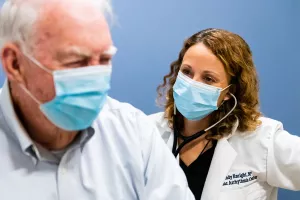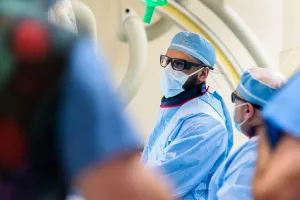Arrhythmia is a condition where the heart isn’t beating properly — either too fast, too slow or irregularly. We can better understand how to treat and cure arrhythmia thanks to the power of electricity. An electrophysiology test looks into your heart’s activity and electrical system and is 1 of the key tests we use to diagnose arrhythmia.
Helping your heart maintain a healthy rhythm
Did you know that your heart is powered by electricity? It produces electrical signals all by itself. These signals tell your heart when to pump blood or contract, which is what creates your heartbeat.
Sometimes, those signals get crossed, making your heart beat irregularly. This is called arrhythmia, and it happens for a variety of reasons. While it's not always a serious or chronic condition, it can have a major effect on your heart and overall health.
Our electrophysiologists use their understanding of the heart's electricity to treat arrhythmias using the latest techniques, like radiofrequency ablation and cryoablation. Along the way, we'll help you understand the cause of your arrhythmia and offer heart-healthy guidance to keep it on beat.

Conditions
Sometimes, arrhythmia is a symptom of another condition, like:
On the other hand, other factors can lead to an irregular heartbeat, like:
- Caffeine
- Excessive alcohol consumption
- Nicotine
- Side effects from medications
Once we understand the source of your arrhythmia, we can create a treatment path that addresses it as effectively as possible.
Testing
Arrhythmia is usually diagnosed by a cardiologist. We have a variety of tools we can use to get to the root cause of your condition, and may use 1 or more of the following to better understand your heart health:
- Electrocardiogram (ECG): This test measures your heart’s electrical activity and tracks abnormal rhythms.
- Echocardiogram: This test is a special kind of ultrasound for the heart.
- Holter monitor: Sometimes, we want to track your heart’s activity over a longer period of time. A Holter monitor is like a portable, wearable ECG that tracks your heart’s electrical activity over 24 hours or so.
- Stress “exercise” echocardiogram: We’ll watch how your heartbeat changes while you exercise.
Treatments
There are several approaches for treating arrhythmia, from minimally invasive procedures called ablations to implanting devices in your chest to aid your heart's healthy rhythm.
Ablation
Some arrhythmia treatments call for a minimally invasive practice called ablation, where a small piece of tissue is removed from the heart for examination.
Catheter ablation for atrial fibrillation (AFib)
A catheter ablation for AFib is performed to reset your heart's rhythm. Most often, we can treat your condition using thin tubes called catheters that are threaded through your veins and up to the heart. This catheter-based treatment falls under the interventional cardiology medical specialty, where doctors can treat complex heart conditions using only a small incision.
During a catheter ablation for AFib, we'll create tiny scars that build tissue in your heart to help your heartbeat stay in rhythm. To create the scars, we use catheters delivering 2 kinds of energy:
- Cryo (freezing energy)
- Radiofrequency (heat energy)
A catheter ablation takes about 3–4 hours to complete, and you'll be put under general anesthesia. After the procedure, most people return to their normal activities in a few weeks.
Ablation for supraventricular tachycardia (SVT)
SVT ablation is primarily used to address fast heart rhythms caused by faulty electrical signals coming from the top chamber of the heart.
This procedure takes about 3–4 hours to complete. You'll be awake for some parts of the surgery, although we'll give you medication beforehand designed to help you relax. You'll be able to get back to most activities in a couple of days, but might have to wait a little longer before exercising or doing other strenuous activities.
Maze procedure
If other ablations or medications haven't successfully addressed your arrhythmia, we may recommend the minimally invasive Maze procedure. During this procedure, a cardiothoracic surgeon will work with one of our electrophysiologists to do several "mini ablations" created by radiofrequency (heat energy). Afterward, you can get back to your daily routine in a few days.
Pacemaker implant
A pacemaker is a device that helps control your heartbeat. Pacemakers have 2 parts:
- Wires with small electrodes that attach directly to the heart
- The small device itself, which generates an electrical pulse
Implantable cardioverter-defibrillator (ICD)
An ICD is a device used to treat weak hearts (cardiomyopathy) and potentially life-threatening arrhythmias like ventricular tachycardia or ventricular fibrillation. These devices monitor the heart continuously and convert a potentially dangerous rhythm into one that will avoid a life-threatening cardiac arrest.
There are 2 types of ICDs: transvenous and subcutaneous. The main difference between them is where they're implanted:
- Transvenous ICDs are inserted through the veins near your chest.
- Subcutaneous ICDs are placed under the skin.
Implantable loop recorder
If your arrhythmia only affects you from time to time, an implantable loop recorder might be right for you. It doesn't assist or manage your heartbeat but tracks and records your heart's rhythms for up to 3 years. That information helps us better understand how to address your arrhythmia.

From regular office visits to inpatient stays, find the healthcare you need and deserve close to home.

Meet the doctors and care team devoted to supporting you every step of the way along your path to better health.